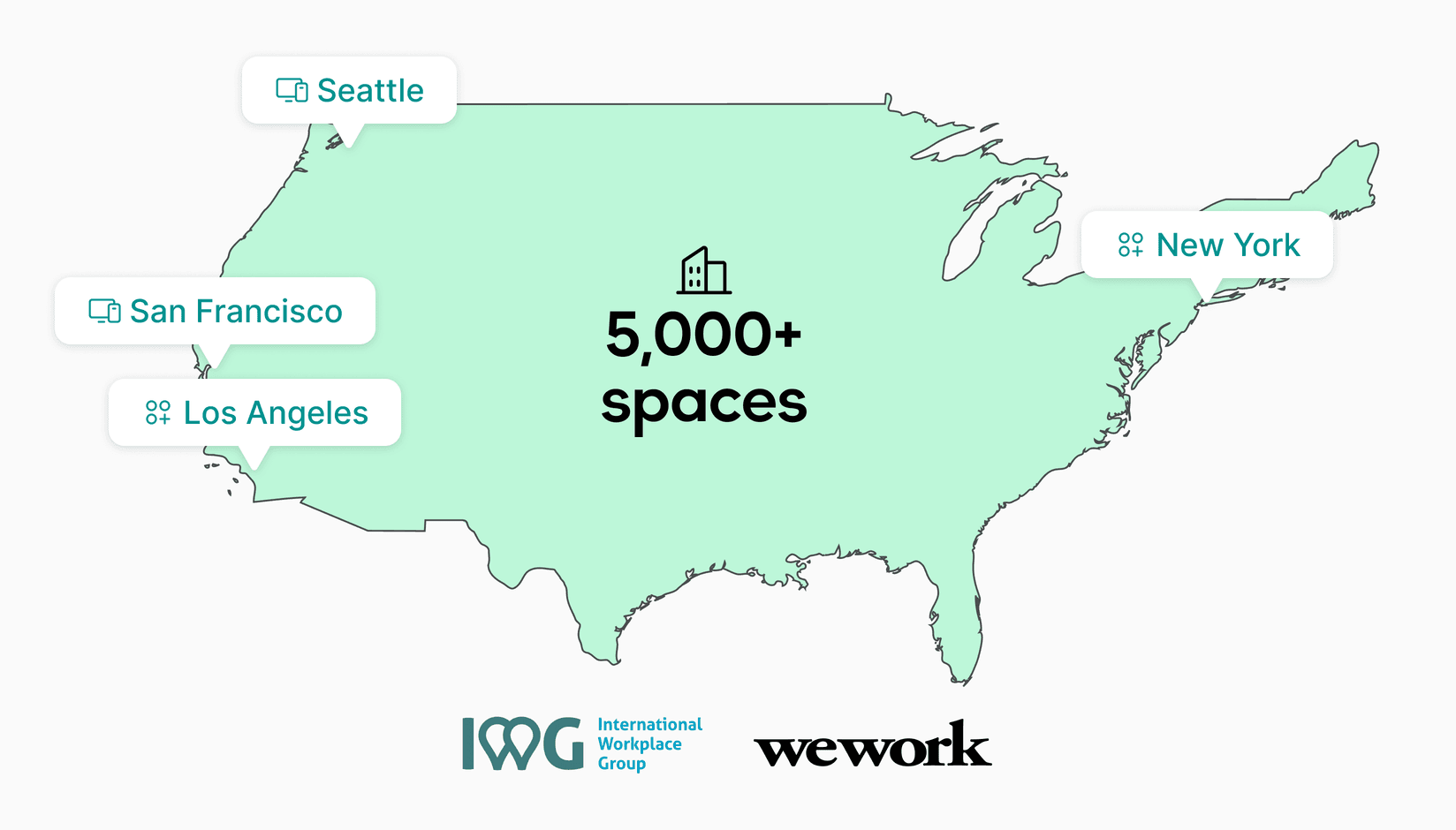- Features
- Solutions
- Pricing
- Resources
- Contact
- Book a demo

The workplace landscape has transformed significantly, especially since the global shift towards hybrid work models. This evolution has ushered in a pivotal role for coworking spaces, which are now essential in supporting the varied work arrangements that modern professionals demand.
Coworking spaces offer the necessary flexibility and provide professional amenities that cater to today’s dynamic workforce, making them an indispensable part of the modern employment ecosystem.
In this article, we will explore how coworking spaces adapt to remain relevant and beneficial amidst the rise of hybrid work. We’ll discuss the key advantages, challenges, and innovative strategies they implement to thrive. Insightful case studies will illustrate successful adaptations, offering valuable lessons and guidance for businesses looking to integrate coworking into their hybrid work models.
The Rise of Hybrid Work Models
Hybrid work models mix remote and office work, changing how we think about where and how we do our jobs. Littler Mendelson PC reports that over 70% of US employers currently support this blend of working from home and the office, showing that this trend is here to stay. Additionally, McKinsey found that about 37% of office workers can split their work week between home and the office.
A WFH report shows that 12.7% of full-time employees work entirely from home, while 28.2% are in a hybrid setup, indicating a clear shift towards more flexible work arrangements. The desire for a better work-life balance and the ability to work more flexibly are the driving forces behind this change. Interestingly, 98% of workers like the idea of working from home at least part of the time, and 87% of people believe working this way makes them more productive.
According to Apollo Technical, this shift is also reshaping traditional office environments, with only 16% of businesses requiring employees to be in the office full-time. This poses challenges and opportunities for coworking spaces, which need to adapt to stay useful. They must rethink their spaces and services to meet the needs of today's workers, who expect flexibility and access to professional work environments when needed.
Advantages of Coworking Spaces in a Hybrid Work Environment
Coworking spaces are becoming increasingly important for people who work at home and in the office. These spaces provide excellent opportunities for networking and building a community, which is especially valuable as usual office interactions become less common. This community aspect helps combat the isolation that sometimes affects those working from home.
In addition to offering a social environment, coworking spaces are equipped with professional amenities not usually found in home offices. These include
- fast internet,
- high-quality meeting rooms and
- advanced technology.
All these amenities are essential for effective work in a hybrid model. Access to such resources ensures that work can be done efficiently and without home distractions.
Furthermore, using coworking spaces can lead to better job satisfaction and productivity. The same McKinsey report earlier cited shows that people working remotely from coworking spaces typically earn about $74,000 a year, much more than those who only work in an office setting. This suggests that coworking spaces' supportive and well-equipped environment helps people work better and positively affects their career success. These spaces help maintain a good balance between work and personal life while helping people stay productive.
Challenges Facing Coworking Spaces
As coworking spaces evolve to meet the demands of a hybrid workforce, they face several significant challenges that need careful management. Addressing these challenges requires coworking spaces to continuously innovate and adapt, ensuring they remain appealing and valuable to their diverse clientele.
Health and Safety Measures
Coworking spaces must prioritize enhanced health and safety protocols in light of ongoing health concerns. This includes regular sanitization, air quality management, and spacing arrangements to ensure members feel safe and protected while using shared spaces.
Competition with Home and Traditional Offices
Many individuals have set up practical workstations at home. Coworking spaces must offer distinct advantages such as superior networking opportunities, professional amenities, and a change of scenery that home offices cannot provide.
As traditional workplaces adapt to hybrid models, coworking spaces must distinguish themselves by offering more flexible terms and additional services like event hosting, workshops, and collaborative opportunities that traditional offices may lack.
Maintaining Community Engagement
With the shift towards hybrid work models, maintaining a vibrant community within coworking spaces has become more challenging. According to McKinsey, reduced physical attendance, now averaging just 3.5 days per week, makes it difficult to sustain the informal interactions and spontaneous collaborations that define coworking culture.
Spaces must innovate community-building activities and virtual engagement strategies to keep their members connected and engaged.
Strategies for Coworking Spaces to Thrive

To remain competitive and appealing in the evolving work environment, coworking spaces must adopt innovative strategies that address the specific needs of their hybrid workforce.
1. Embracing Technological Integration
Advanced booking and space management systems are crucial for accommodating the irregular schedules of hybrid workers. By implementing technology that supports flexible use of space, coworking facilities can align more closely with modern work patterns where employees spend fewer days in the office.
Adapting to these hybrid work patterns with flexible and responsive management systems ensures that coworking spaces can provide seamless services that meet the dynamic needs of today's professionals.
2. Designing for Flexibility and Wellness
Coworking spaces should consider designing modular areas that can be easily adjusted to meet varying team sizes and requirements. Additionally, integrating wellness areas into the workspace design can significantly enhance work-life balance for members.
These spaces include quiet zones for relaxation, fitness areas to promote health, and ergonomic workstations to prevent strain and injury, thus creating a holistic environment that supports professional productivity and personal well-being.
Building a Community
To keep the spirit of collaboration and interaction alive, coworking spaces should host events and workshops that resonate with the interests of hybrid workers. These gatherings are essential for fostering a community feel and encouraging networking and professional collaboration among members.
Regularly scheduled social events, professional development workshops, and casual meet-ups help maintain the communal vibe that often sets coworking spaces apart from traditional office settings.
Focusing on Niche Markets
Coworking spaces can also thrive by focusing on niche markets and catering services to specific industries or professional needs. These spaces can attract professionals who require specific tools or environments by offering specialized resources or equipment not typically available in home offices.
For example, developing quiet, tech-enabled areas can be ideal for individuals enrolled in master's degree programs. These setups provide a conducive environment for focused study and participation in virtual lectures, making coworking spaces an attractive option for those seeking a supportive community and professional amenities to enhance their educational pursuits.
Case Studies: Successful Adaptations
Coworking spaces worldwide have effectively adapted to hybrid work models, significantly improving operations and member satisfaction. Here’s a brief look at several cases that illustrate successful strategies and the lessons learned:
- MY WORKSPACE, Seoul, South Korea: Faced with a manual room booking system that led to conflicts and revenue losses, MY WORKSPACE implemented Spacebring's automated booking system. This allowed 24/7 self-service bookings and completely eradicated conflicts, enhancing operational efficiency and saving $1000 monthly on management costs.
- The Lab on Dexter, Montgomery, US: The space struggled with inefficient software for member onboarding, invoicing, and room bookings. Adopting Spacebring to automate all processes and streamline event management significantly reduced administrative time and improved member satisfaction.
- Embassy House, Stockholm, Sweden: The use of multiple disjointed tools for managing bookings, payments, and communication was hindering Embassy House. They moved to integrate all functionalities into Spacebring’s single platform solution, resulting in faster setup times and significantly reduced time spent on member support, boosting customer engagement.
- Hustle, Albury, Australia: Hustle encountered inefficiencies with multiple apps for bookings and invoicing. Transitioning to Spacebring automated invoicing and streamlined room bookings, which saved substantial administrative time and led to higher revenue through improved operational efficiency.
- Generator Hub, Exeter, UK: A complex booking system and cumbersome invoicing process posed a challenge for Generator Hub. So, they simplified these processes and enhanced community engagement with Spacebring, achieving 130% membership growth and improved revenue.
- FoundrSpace, Pasadena, US: FoundrSpace dealt with inefficient manual management of bookings and tracking of free hours. Spacebring’s booking and credit management automation significantly reduced administrative burdens and enhanced user satisfaction.
- Workps, Santa Fe Springs, US: Workps faced challenges with their website for bookings and the time-consuming management of routine tasks. By consolidating all operations into Spacebring’s integrated platform, they experienced a 757% revenue increase within one year and greatly improved efficiency.
Embracing the Future of Hybrid Work
The world of work is continuously evolving, and with it, the need for adaptability and innovative solutions becomes more critical than ever. Coworking spaces have risen to the occasion, offering flexible, community-focused environments that cater to the diverse needs of today's hybrid workforce. By embracing change and leveraging technology, these spaces survive and thrive, proving indispensable for businesses and individuals.
As we conclude, it's clear that a coworking space tailored with Spacebring's tools is not just an office alternative—it's the heartbeat of a professional community. It's where ideas flourish and productivity soars.
- Schedule a personalized demo: Witness the simplicity and power of Spacebring in streamlining operations.
- Explore our features: Delve into Spacebring’s features that elevate coworking spaces beyond the ordinary.
Consider Spacebring your partner in pioneering the future of work. Let's make your coworking space where tomorrow's ideas come to life today. Reach out for a demo and step into the future with Spacebring, where work is transformed into progress.
Keep Reading

The Ultimate Guide to Adding Co-Living to Your Coworking Space

Find Your Tribe: European Coworking Day 2024 Connects Professionals Across Europe

Get Ahead in Coworking: London Conference 2024

